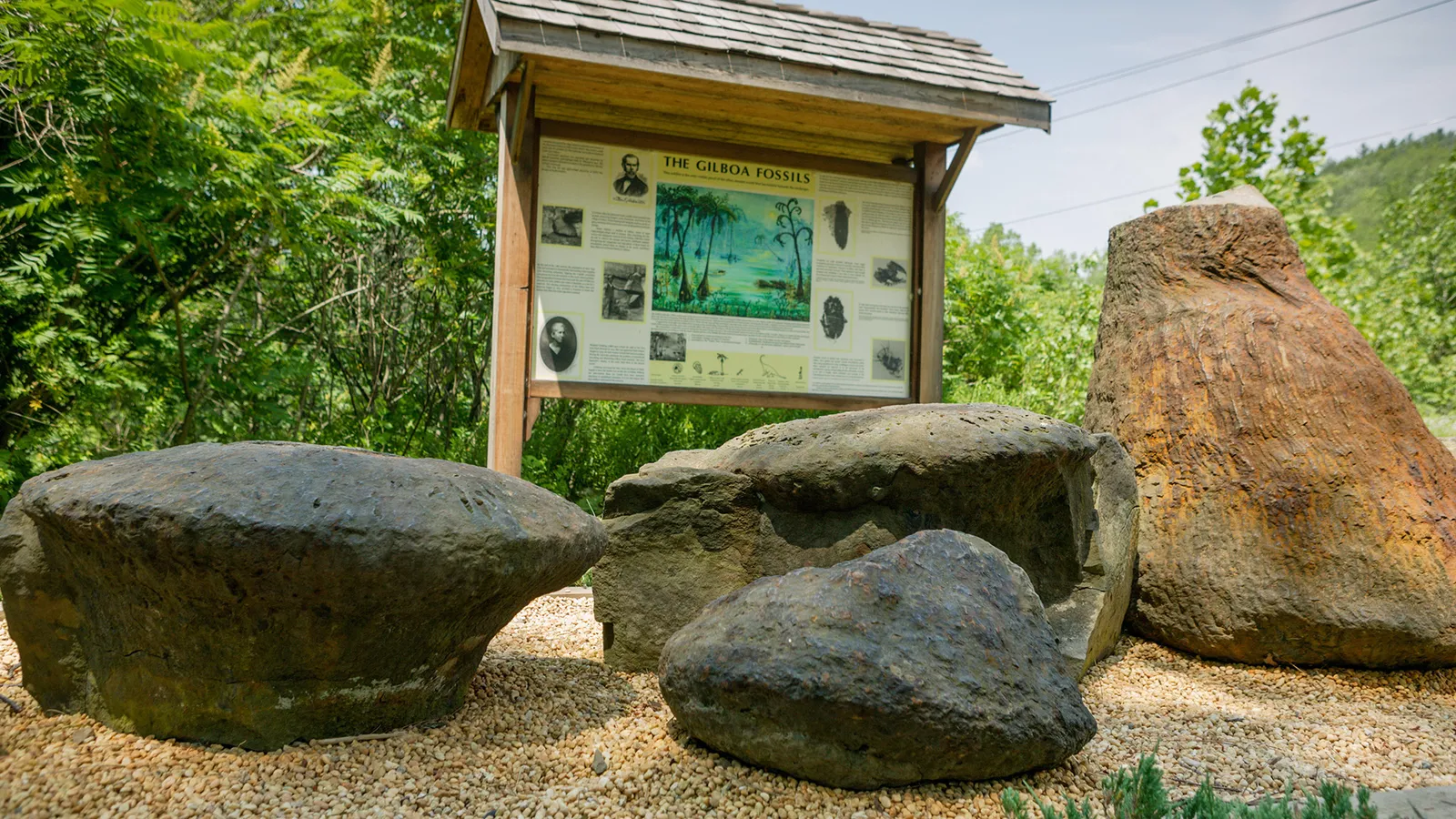The surprising US region that's home to the world's oldest forests
The discovery of a 385-million-year-old forest in Cairo, New York, has stunned the world – but visitors to the region have been able to see rare and ancient fossil forests for more than a century.

Picture a hot, tropical landscape near the equator full of shallow seas. Birds and invertebrates don't yet exist. Neither does the Atlantic Ocean. Instead, a mountain range the height of the Andes looms over fragile stretches of trees that resemble palms.
This is what New York state looked like during the Devonian period, roughly 400 million years ago. It was a pivotal moment in time when forests as we now know them first appeared on Earth, radically shifting the planet's climate.
There are Devonian rocks scattered across the world, but during the 19th and 20th Centuries, the town of Gilboa, New York, became world famous for the discovery of its rare fossil forests (groups of preserved tree stumps containing the remnants of ancient trees). They were recognised as the oldest in the world at around 380 million years old.
That is, until the 2018 discovery at a quarry in nearby Cairo, New York, revealed evidence of a 385-million-year-old forest, which has been estimated to be two to three million years older than Gilboa. In January 2024, the Cairo discovery hit the news again, when the site received funding to protect the currently off-limits area as a first step towards turning it into an educational site and scientific preserve.
Fossils are constantly popping up in the region. Since approximately 10% of New York has Devonian rocks, the Catskills and the counties north of them are a dream for hikers and rockhounds alike.
"More fossil forests have to be scattered throughout the Catskills region, in rocks deposited by rivers onto land," said Dr Charles Ver Straeten, a Devonian geologist and curator of sedimentary rocks at the New York State Museum. "There must be thousands of fossil forests preserved here, just not easily found under modern forests and soils."
Ver Straeten was part of the discovery of the world's oldest forest ecology at the Cairo quarry. He was out digging one day in 2009 with his colleagues Linda Van Aller Hernick and Frank Mannolini when he noticed an unusual gutter-like imprint. Over the years, the trio traced the impressions of 11 large root systems, some six to eight inches across, on the world's oldest forest floor. In 2018, they acquired a drone, which allowed them to survey the large tree imprints from above and understand the full scale of the root systems for the first time. They found at least three types of trees here, which grew at a pivotal point in environmental history.
Scientists are still learning about these ancient trees that may hold clues to unanswered questions about the evolution of ancient forest ecosystems and climate changes.
With the origin of forests, carbon dioxide levels in the atmosphere dropped, which cooled global temperatures. Trees that could absorb carbon dioxide and provide shade, like those found in Cairo and Gilboa, led to the global cooling in the Paleozoic era (541 to 252 million years ago) and ultimately helped creatures evolve into land-dwelling vertebrates. With extensive deforestation worldwide and an increase in carbon dioxide levels, we're now seeing a similar climate change process but in reverse.
The ancient environments in Cairo and Gilboa were markedly different. Gilboa had water-soaked forests punctuated by catastrophic floods that moved massive amounts of sand. Cairo saw a quieter environment with both wet and dry periods. A final flood event in Cairo most likely killed the trees in the forests, preserving them like a snapshot in time. Gilboa's trees experienced a similar snapshot event, but in that case, water helped entomb the trees in sand, creating sandstone casts.
"At the beginning of the Devonian, about 420 million years ago, the tallest plants were only several inches tall. There were no leaves at that point and all the plants were spore bearing. By about 30 million years later, in the middle of the Devonian Period, plants had evolved to tree sized. Gilboa was the first place to make such a major discovery," explained Ver Straeten.
Some of these fossil casts (the remainders of the Gilboa fossil forests) are now on display at the Gilboa Museum, roughly 40 minutes north-west of Cairo. Gilboa was a thriving town in the late 19th Century but was evacuated and turned into a watershed in 1927 to provide a growing New York City with fresh water. It was during that process when palaeontologists discovered around 40 unique tree fossils, which thrust Gilboa onto the paleontological world stage.
"Our ancestors all lost their homes in Gilboa during the building of the dam that flooded the town, but the positive thing is that they found these Gilboa fossils. They generate a lot of information for the world because these are the first forests that live on Earth and absorbed carbon dioxide," explained Kristen Wyckoff, a fossil enthusiast, an original founder of the Gilboa Museum in 2005 and the current vice president of the Gilboa Historical Society. "We're among the oldest trees in the world now."
One tree in particular dominated the ancient Gilboa fossil forests: Eospermatopteris.
Eospermatopteris trees had an onion-like bulb at the bottom and finger-like roots that extended into the soil. A hollow trunk led to a top with fronds. While it looked similar to a palm tree, the species are unrelated; Eospermatopteris is believed to be more closely related to modern ferns.
Hanging in the Gilboa Museum are two large artworks painted by Wyckoff, depicting what the trees and landscape would have looked like in Devonian times. Large Eospermatopteris dot the coastline of a tropical sea, with cloud cover hovering beneath the tall mountain peaks. She had to redo a painting after a 2011 hurricane revealed several rare fossils in the Schoharie Creek, a river that flows through the region for 150km, including roots from Tetraxylopteris (also called the snake tree), a section of the oldest Arborescent Lycopsid (one of the earliest vascular plants) ever found and a crown portion of Eospermatopteris.
Elsewhere in the museum, there are casts of fossils everywhere. To the untrained eye, they look like segments of tree stumps and rocks with striations. Some have the occasional leaf pattern, like the fossil from the Archaeopteris tree of the late Devonian period, which was found in nearby Delaware County. For years, this was the oldest complete tree fossil ever recorded until Eospermatopteris took that crown.
With its conifers and deciduous trees, plus the significant erosion of the Catskill mountains, this region today looks markedly different than its tropical past when what is now North America lay below the equator. But there are still some remnants of the ancient forests to be found.
"When you walk through the forests in New York, you can see these little plants called ground pines. They're maybe three to six inches on the forest floor. So that group of plants were around in the Devonian," said Ver Straeten.
When you walk through the forests in New York, you can see these little plants called ground pines… that group of plants were around in the Devonian
And there are still fossils to be found in Central New York and the Catskills for those who know what to look for. This summer, the Gilboa Museum will hold its first fossil walks and explorations. While hearing about the ancient geology in the area, participants will learn how to identify fossils – and even attempt to find some. New York State is also in the process of establishing a New York Geological Trail that will reportedly include Cairo and Gilboa.
Slightly south, in the Catskills, hiking through areas like Kaaterskill Clove and North South Lake will reveal forests of dense, tall, woody trees, old in their own right, with branches that stretch tall and wide. They may hide waterfalls, or shale or sandstone rocks, which are remnants from Devonian times. The mountains themselves have eroded over time, but the trees – now seed bearing – have grown and thrived, part of an ecosystem filled with birds, insects and mammals that depend on the trees for food and shelter. The shallow seas and tropical climate are long gone. But all it takes to transport back to Devonian New York is a newfound understanding of the fossil forests and a little imagination.
-bbc





